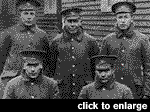
|
 |
A generation of young native Canadian men bravely fought on the battlefields of Europe during the Great War. Approximately 300 of them never returned home alive. Nevertheless, when Canada declared war on Germany on September 10, 1939, the native community once again quickly responded. Four years later, in May 1943, the government declared that, as British subjects, all able Indian men of military age could be called up for training and service in Canada or overseas (Summerby, 1993, p.21). Therefore, in direct contrast to World War I, most natives were not exempt from conscription. By this time however, many able-bodied natives had already voluntarily joined the ranks for overseas duty.
Natives volunteered to fight in the air, on land, or on the high seas. During the first three years of the war enlistment was made difficult by racism. The air force had stipulated that recruits be of "pure European descent" and the Royal Canadian Navy required applicants to "be a British born subject, of a White Race" (Gaffen, 1985, p. 64). Max Basque, an Indian from Whycocomagh, experienced this racism. As a former merchant marine Max travelled to Montreal to enlist in the Canadian Navy:
The Navy recruiting officer looked at me. He said, "Are you an Indian?" I said, "Yes, sir." "Sorry we don't take Indians in the Navy. But... you're not a full-blooded Indian." "No I'm not," I said. "I don't think there's any full-blooded Indians east of Winnipeg!...But on the books I'm an Indian. Here's my border-crossing card." You know, we used to carry those cards, that I'm an Indian, this and that. Didn't have any pictures, like. "Well," he said, "you got a French name: B-a-s-q-u-e. We'll sign you as a Frenchman." I said "No, you won't.... That's not a French name, anyway. It's Basque--it's from northern Spain." "Well," he said, "we'll sign you on as Basque." I said, "No. On the books, I was born on the Indian reservation and I've always gone as an Indian all my life.... What in the world? Disown my own race, just to get into the Navy?" I said, "I'm a Canadian, even if I am an Indian. Same as you are....I was born here in Canada." Max Basque never did join the Canadian Navy (Cape Bretons Magazine, No. 52, p. 58). |















